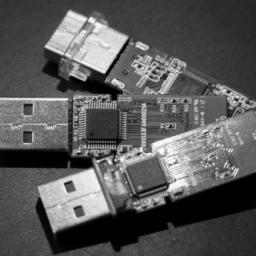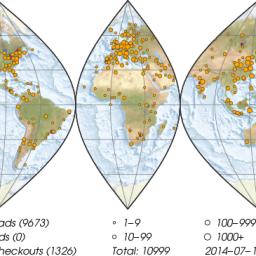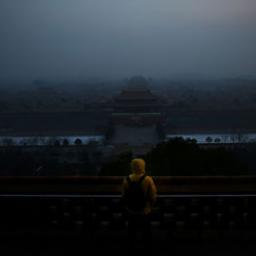As of today, the
press statement is out for the release of Oracle's VirtualBox 5.0. This comes 4-6 months after
an inquiry started about whether Oracle had abandoned further development of VirtualBox following 2013's v4.3. Infoworld's
April 2, 2015 review of the VB 5.0 beta states "don't expect anything truly revolutionary... but its main advantage over VMware remains with its offer of a free incarnation of many of the same core features."
Highlights for the new release include support for USB 3.0 Devices and Disk Image Encryption, among other things.
Naranda Modi (prime minister of India) and Stephen Harper (prime minister of Canada) recently met in Toronto where
they announced a new 5-year agreement for India to purchase uranium from Saskatoon's Cameco corporation to generate nuclear energy in India. In
an article at thehindu.com, Modi is reported as describing India's moves to support the so-called "saffron revolution" in which his administration is growing their commitments to nuclear, solar, wind, biomass and energy saving missions in India. The Hindu article states that: "At the heart of Mr. Modi's speech was his repeated assertion,
jan man badla hai, or "The minds of the people have changed," over his 10 months in office, and that India was finally on the move".
The announcement arrives at the same time that the journal Nature has published
an opinion piece by Alan Rusbridger, editor--in-chief of the Guardian (London), that scientists must increase their professional and personal activism against the search and use of new fossil fuel energy sources. Rusbridger notes that: "the Guardian Media Group has, in the space of two months, moved from not really thinking very much about the issue to announcing that its 800-million (US$1.2-billion) fund will divest from fossil fuels within 2-5 years".
These events beg the question of which countries and technologies will be the winners and losers in the reshaping of the global energy supply in the coming decades and what the economic value of yet-to-be-exploited hydrocarbon resources will be going forward as well?
Popular Science recently
reported on a wearable air quality monitor designed and prototyped by electrician, Kevin Hart, and nurse, Laura Moe. They are targeting a late fall 2015 release at a price point of $100 (US).
From the article, "A fan directly beneath TZOA's triangular cover sucks in air. As pollutants cross a laser, they scatter light onto a sensor that counts them. TZOA then glows a color corresponding to the air safety level. A smartphone app also displays that data, along with daily UV light exposure and crowdsourced pollution maps."
The
Canadian Broadcasting Corporation reports that two researchers have stepped down from the Science Hall of Fame selection panel over claims that cultural bias is limiting the number of female researchers nominated for the honour. No female researchers have been nominated for two years running and former panelists Judy Illes and Catherine Anderson argue in their resignation statements that the lack of nominations reflects a cultural bias that fails to reflect the contributions women make to science nationally and globally.
Anecdotally, the gender bias claims echo how the work of Rosalind Franklin was rewarded in her lifetime following the discovery of the structure of DNA. As
a Wikipedia summary notes: "Franklin is best known for her work on the X-ray diffraction images of DNA while at King's College, London, which led to the discovery of the DNA double helix. According to Francis Crick, her data and research were key in determining the structure. Watson confirmed this opinion in his own statement at the opening of the King's College London Franklin-Wilkins building in 2000 and formulating Crick and James Watson's 1953 model regarding the structure of DNA. Franklin's images of X-ray diffraction, confirming the helical structure of DNA, were imprudently shown to Watson by Wilkins without her permission. Her work was published third, in the series of three DNA Nature articles, led by the paper of Watson and Crick. Watson, Crick and Wilkins shared the Nobel Prize in Physiology or Medicine in 1962. Watson suggested that Franklin would have ideally been awarded a Nobel Prize in Chemistry, along with Wilkins."
A
new report out of Canada suggests that high numbers of students at Canadian universities involves the acceptance of too many "marginally talented" students. University of Saskatchewan researcher, Ken Coates,
has proposed reducing Canadian university student populations by 30% -- to be complemented by an increased emphasis on job training programs at technical colleges -- to improve the education and employment outcomes of all student cohorts.
A
Council of Ontario Universities report from 2014, entitled University Works, provides a counter-argument to this narrative, however. According to
a summary article, the earlier report claims that "over 40 years, a university graduate earns an average $915,840 more than a college graduate and $1.4 million more than a high school graduate" reinforcing the long-standing idea of the greater return on investment supplied by a general university degree.

An
interesting discussion appeared on
MacRumors today pointing to the work of security researcher Karsten Nohl of Berlin's
SR Labs. He has discovered an attack vector exploiting the firmware of generic USB devices. It appears that with the vector involves reprogramming the USB controller software for arbitrary devices which can than emulate other devices to cause a large variety of undesired outcomes (such as emulating a keyboard to type on behalf of a user or spoofing a network card and redirecting web traffic). At present, this attack vector appears to be impossible to prevent or detect with existing software-only security measures. A more detailed discussion of Nohl's work and the associated risk are
available from Wired or the
SR Labs website itself.
A notable quote from the Wired article:
"Blaze speculates that the USB attack may in fact already be common practice for the NSA. He points to a spying device known as Cottonmouth, revealed earlier this year in the leaks of Edward Snowden. The device, which hid in a USB peripheral plug, was advertised in a collection of NSA internal documents as surreptitiously installing malware on a target's machine. The exact mechanism for that USB attack wasn't described. I wouldn't be surprised if some of the things [Nohl and Lell] discovered are what we heard about in the NSA catalogue....The alternative is to treat USB devices like hypodermic needles."

The
QGIS Project released the latest 2.4 version of their free and open source QGIS geospatial information system software a week or so ago (codename Chugiak). The
2.4 changelog lists a number of new features that indicate the QGIS software is increasing in data analysis and map composing sophistication, i.e., moving beyond its traditional strength as a geospatial data management interface. One new feature that seems especially exciting is the
multi-threaded rendering which allows users to continue to interact with the map views while re-rendering of the map is ongoing.
Anyway, I've been using QGIS almost exclusively in my own research for the past five years or more -- although I have been preparing final figures and maps using
Generic Mapping Tools scripts because of perceived limitations with previous iterations of the Map Compositor functionality in QGIS. However, my place of work and many of my colleagues continue to use the commericial
ArcGIS suite of software for GIS and Map preparation tasks and so, out of necessity, I am constantly switching back and forth between the two.
I remain convinced that for many people's workflows, QGIS is a hugely competitive product because it is free and supports a wide range of GIS activities. QGIS functions are only getting more numerous and sophisticated with time.
I thought I would take the 2.4 release of QGIS as an opportunity to ask the Pipedot community if they had any ongoing experience switching from ArcGIS to QGIS or supporting both platforms concurrently? As well, what points of comparison would Pipedot contributors emphasize in considering the QGIS versus ArcMap question? Thanks!

This week's
Monday poll showed general consensus that scientists should be focusing on energy technology. Looks like some of them are doing just that, and who better to deal with heat and huge flames than a rocket scientist?
The
Telegraph reports that
a rocket scientist from Oxford University has reinvented the saucepan. The new design, developed by
Dr. Thomas Povey, has regular channels incorporated into the pan's sides which allows heat delivered to the base to be captured more efficiently as it moves upwards around the pan's sides and testing indicates that it requires forty percent less energy to achieve equivalent cooking results compared with previous saucepan designs. According to the article, Dr. Povey originally hoped to improve the efficiency of cooking in the outdoors, but decided to develop his new
Flare Pan design when he realized that the domestic market could also benefit.
A short
summary video on the development and testing of Dr. Povey's new Flare Pan design is available on the Oxford University website.
[ed. note: the appropriate way to test this pan is with some good bacon, and as mentioned
here, with a case of beer, for science.]




